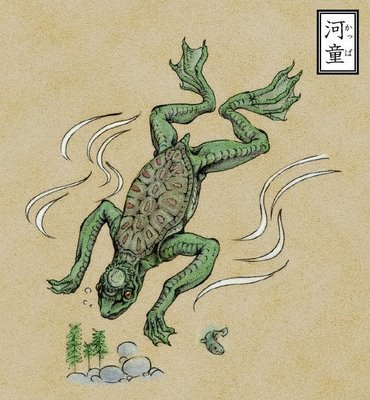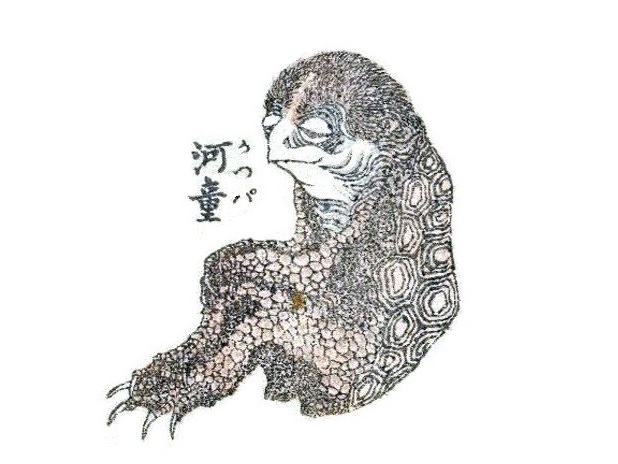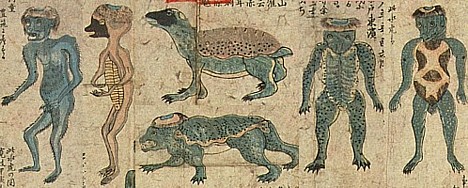
.
There are many myths and legends about strange amphibious, web-footed aquatic beings that surfaced Medieval Japan. There is also a very ancient and only partly known, animistic cult still performed in the Gobi Desert on the north of Mongolia that is considered to be related to the same beings.
The shamans performing this cult claim to communicate with black, hunchbacked creatures, with long claws that have the power to ‘cast their skin’ and immediately assume human form.
.

.
These shapeshifters can go unrecognized; however, when clad in their ‘dark skin’ they are said to be invisible and to sail or fly in great shells, over the waters or through the clouds, according to the ‘Book of Fire’ (Ghal Sudur), in which all ancient traditions of the region are mentioned.
.

.
However, we know that many “legendary and fabulous” creatures existed in reality and the mysterious humanoid creatures known as “Kappas” could be one of them.
Peter Kolosimo who analyzed the vast store of information about the human past and the evidence of extraterrestrial beings on Earth in prehistoric time, writes that Professor Komatsu Kitamura, an archaeologist and historian presented his view on the Kappas, in an article published by Mainichi Graphic magazine.
Kitamura said as follows:
“I was led to this hypothesis in the first instance by a print illustrating an old work on the history of the legendary Kappas or “men of the cane-brake” who are said to have inhabited Japan in the Heian period (ninth to eleventh century AD).
They are described in the old texts as web-footed bipeds with three hooked fingers on each hand, the centre digit being much longer than the others. Their skin is brown, smooth, silky and lucent; their heads are elongated, they have large ears and strange eyes of triangular shape and they could move with equal rapidity by land and sea.”According to all reports, they wear a curious kind of hat “with four needles in it”; their nose is like a proboscis and is connected to a casket-shaped hump on their backs.”
“Considering the Kappas more closely, I suddenly realized their startling resemblance to modern frogmen,” Professor Kitamura said.
Their “smooth brown skin” could have been a close-fitting waterproof suit, their webbed hands and feet, and the hooks on their fingers and toes, would be suitable equipment, and the “proboscis” and “hump” would of course be breathing apparatus, complete with oxygen bombs.
As for the “four needles”, I am tempted to believe that they were radio antennae..”
The mysterious Kappas are not a fantasy because there is enough evidence that confirm their existence.On the other hand, it is hard to believe that more than 1000 years ago, the Japanese people had a special talent for diving and equipped with waterproof suits, were occupied with penetrating Japan’s watery realms.
So, if these beings were not the Japanese themselves, the only other alternative conclusion is that they were strangers and came from outer space.
.
.
And once again, the ancient tales about the Kappas seem to confirm this conclusion because they mention vehicles ‘like great shells, able to move swiftly over the waters or through the heavens’.
According to these stories, the Kappas often came ashore, and taught the natives various advanced arts.
The medieval Japan chroniclers also claim that these beings lived in large ‘shells’ floating quietly on the water. At the same time, almost momentarily, the shells were able to shoot skyward at tremendous speeds and disappear out of sight!
Were the mysterious Kappas in constant contact with space vehicles orbiting the earth – a mothership, perhaps?

No comments:
Post a Comment